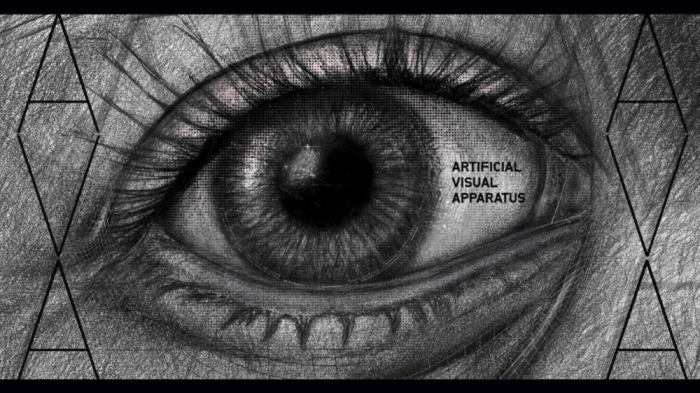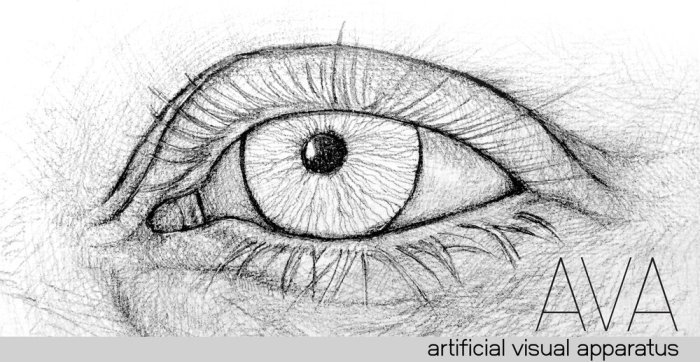
Air force pilot intelligence officer Sandy experiences identity transformation after realising she has been artificially built and controlled by a cybernetic existence.

An action research framework supports the practice-led approach into the making of a short animated film that explores the communicative potential of a digitally designed eye to express complex and shifting human emotions.
The advanced creative practice will gain insight into dynamic generation of a life-like human eye as a central driver for communicating emotion and realism in digital humans. The project is interdisciplinary, drawing on knowledge in artificial intelligence, facial anatomy, cinematography, directing actors and narrative design. Contextually research framework predominantly contributes to scholarly areas in character driven design, digital robotics, creative filmmaking and medical visualisation. Drawing traditionally with pencil as a method of observing features that change over time unfolds visual literacy in sensing attention required to implement higher level of realism. The methodology accommodates key elements affecting emotional intensity expressed in nuances as focused picture in facial performance.
The embodiment of digital sculpting as the practical research method is aimed to increase understanding of our response to the human eye.


The blend between humans and machines is the prime focus of the work including the representation of the artificial life in popular culture. The application of the practical knowledge is in the three dimensional computer simulation utilising the investigation of the pre-defined facial performance capture. Cyber culture theories are the core of the project basis and the research in body and technology merge process. The main key concept is the book New Media: A Critical Introduction with particular focus on cyber culture and theories of artificial intelligence as a virtual mind in media in addition to simulation of bioinformatics of the DNA code. Imagine the clock as the origin of existence and the reason of being by looking how the internet technologies converge in conjunction with futuristic vision. The question of disembodiment of the mental code falls into the category of cybernetics and history of automata to give a broader sense for the project design.
Mainly this text is dealing with the ideas of a human intelligence being present inside the digital computer and how those ideas described in Marx theories in cross correlation to the relevant historical texts. The vision of cyborgs first came from Phillip K. Dick novels. The fact that the machine won human in chess make absolute sense because it confirms that the machine is capable of the decision making process. Technology around us is intelligent and it is shown in popular cultures, in film Terminator (J.Cameron, 1984) with its first vision of the human android, reflected in a similar way in Blade Runner (R.Scott, 1982) including Japanese manga and anime. This is introduced in the text that is key to the project development, ideas as such as what is real and what is not, what is virtual world with virtual human, that could have a digital personality. Additionally in how those ideas affect the media with the stereoscopic 3D, trans-media realities and immersive experiences. Feature Film The Matrix (Wachowski, 1999) has the representation of the idea that the mind as a substance to have an intelligently structured code of the skill set of a particular person to be utilised for alternative purposes of the machines. Imagine the body that was connected to the unit of an intelligent mainstream dataset of artificial intelligence and located on the board of the machine race spaceship.
The techno-science was always reflected in the core of Marx’ materialistic concepts and his first views of living machines, automata comprising intellectual and mechanical organs. There was always a question of the hero’s identity to realise who he is or she is, identity struggle and self destruction which is accomplished in the project by focusing on the human facial expressions. Cyborgs are living machines with artificial intelligence that is the driver for the project. From one point of view it is realistic to say that machines are alive and yet from the second point of view it is not the case. The machines are for the service of people needs rather than having the intellectual control over the population. Other relevant texts discuss the process of facial animation and principles of articulating visual language. Those might not be a complicated rendering process and yet an artificial accomplishment to animate human face by simulating the reality. That is the point where the immersive experience takes another dimension and merges the real and virtual including traditional media such as motion picture and the ability to draw onto its reality through the screen space. In the film Avatar (J.Cameron, 2009) the simulation of reality went up to eighty percent of the experience by allocating the performance of the actors into the three dimensional virtual sets. The theoretical background did aim to explore the future of the planet Earth and the vision of the future by referencing and contextualising the science fiction perspective on the existed historical wars. There is also a concept of artificial machine with the ability for technological advancements. The DNA compatible technology to mix human code with avatar body and translate the physical control of the body. The key significant concept here is the control to execute in addition to the story for actual project. The narrative is based around the concept of control of the flying vehicle while the mind that is connected to the series of machinery parts of the spaceship. Furthermore the creation of the artificially intelligent character mixed with human side reflects on the study of the uncanny valley syndrome to recognise and decide if this is a real human or a simulated cyborg. This is achieved by the company Image Metrics Inc. when creating a virtual human with published Siggraph document on the Digital Emily project. The simulation of the live human facial expressions with realistic research in skin structure and lighting theory. The exploration of displacement and normal maps in order to achieve a realistic character appearance. The important connection with the idea of automation and merging realities is the performance driven simulation technology that is coming through the virtual character to have its unique personality.
It is fascinating that the digital data is not alive and simply a simulated reality. In the same time it challenges the mind with the question of whether a character is real or not. This is the phenomena of facial recognition and familiarity of the features due to the fact that we all can relate to human faces. In nature it is one of the main non verbal communication languages – mimicry. Following related concepts presented in the anime film The Ghost In The Shell (Mashimoru Oshii, 1995) where the android character is the property of the Section Nine, a department that keep the society in safe hands. The attention is given to the eyes to be realistic and exaggerated to be able to bring a non photorealistic rendering. The fight and conflict between being technological or human incorporated into the character and the main key text the New Media: A Critical Introduction discusses in many chapters by having topics around cybernetics, androids, artificial intelligence, alife, simulacra and hyper reality, virtuality and remote messages of DNA mixed body technology. The project reflects upon the idea of transferring captured performance onto the digital face to be able to represent the artificial intelligence conversation with the hero of the narrative. This is similar to ideas in the motion picture RoboCop (P.Verhoeven, 1987) where the killed man was used in conjunction with machine to solve human salvation. In this case those global changes of the technological developments in societies take completely different meaning. The technology is seen as something helpful.
Those ideas and concepts are represented in the project from technical perspective and from the conceptual angle. Summarising the ideas around cyborgs, androids and artificiality simulated humans, it is about humanity where the flashback sequence of the memories in the film narrative is what actually fuels the picture with meaning. This is driven with the fact that our memories can define our identities and answer the question of who we are. While constructing concepts and ideas around the project it is important to understand intertextual semantics of the piece and logical elements that shape the story for the audiences today. In three dimensional computer animation there is always a challenge to create a realistic simulation of the human face to represent artificial intelligence. In our everyday life the change occurs not only in technological worlds but also in climate realm. The climate does change and the way people use the planet now is aimed to complete the destruction of it. This is the main reason why it is so important to create a creative visual content with representation of the technological obsession, cybernetics and future visions. This will reverse our understanding and acceptance of the artificial intelligence. The survival purpose is to live in harmony with those visions as this will transform the way we live our lives today and make decisions when dealing with technology.
Reference list
Lister M., Dovey J., Giddings S., Grant I., Kieran K., (2009) New Media: a critical introduction. New York: Routledge.
Bay M. (Director). Transformers. [Motion picture]. Beth E. K. & Nakamura L. & Gilbert B.R. (2000). Race in cyberspace. Routledge. New York and London.
Cavallaro D. (2010). Anime and the Visual Novel. Narrative structure, Design and Play at the Crossroads of Animation and Computer Games. McFarland & Company, Inc., Publishers Box 611, Jefferson, North California 28640.
Featherstone M. & Burrows R. (1995). Cyberspace/Cyberbodies/Cyberpunk. Cultures of Technological Embodiment. Printed in Great Britain by The Cromwell Press, Melksham, Wiltshire.
Issac V. Kerlov (2004) The Art of 3D Computer Animation and Effects. John Wiley & Sons, Inc., Hoboken, New Jersey.
Parent R., Ebert S.D., A.D. Gould D., Gross M., Kazmier C., Keiser R., Lumsden C.J., Menache A., Muller-Fisher M., Musgrave F.K., Pauly M., Peachey D., Perlin K., Pfister H., Sharpe J., Wicke M., Wilkins R.M., Woolridge N., Worley S. (2010) Computer Animation Complete. Margan Kaufmann Publishers, Burlington, USA.
Alexander O., Rogers M., Lambeth W., Chiang M., Debevec P. (2008) Creating a Photoreal Digital Actor: The Digital Emily Project. SIGGRAPH 2009 Course notes: The Digital Emily project.
Osipa J., (2008) Stop Staring. Facial Modeling and Animation Done Right. Wiley press: London, United Kingdom.
